Michelangelo images
below are presented under "Fair Use" doctrine, pending approval from
Museums
|
| Who, or What, was
Michelangelo looking at when he made this drawing? |
 |
|
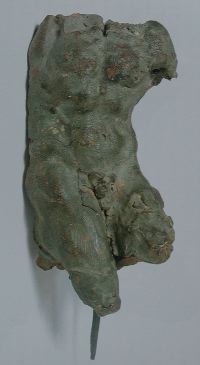
Model of a nude torso
clay
(later painted green)
c. 1520
|
|
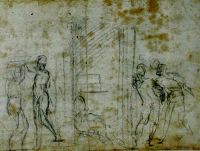
Compositional Sketch for 'Judith
and Holofernes'
Black
chalk on paper
c. 1508
|
|
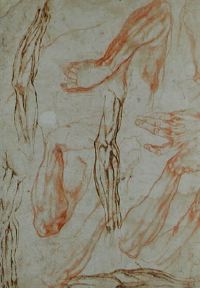
Studies of flayed arms
Pen
and brown ink on paper
(Red chalk drawings on the same sheet were likely made at a different
time, for a different project)
c. 1514
|
|
|
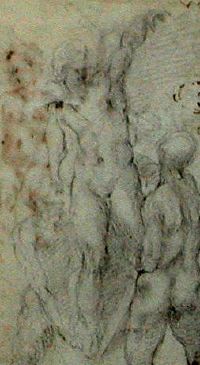
A group of three
nude men
Black
chalk on paper
c. 1504-5
|
|
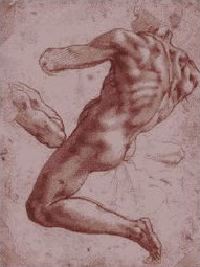
Study for a seated male nude
(Ignudo)
Red
chalk on paper
c. 1511
|
|
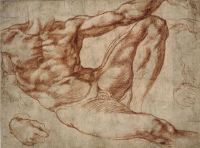
Study for Adam
Red chalk on paper
c. 1511
|
|
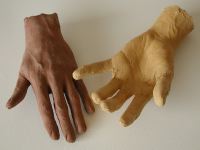
Realistic
"sculpture", these
clay hands
were made from plaster life-casts. An artist could draw these
clay hands so that they seem to be from a live model.
(to reference in text)
|
|

Enlarging
a figure with the correct perspective onto a curved surface is
trivial if one has a 3-dimensional model of the figure. Here
a
small plastic horse is suspended with string. A candle (right
side, lower corner)
provides a light source to cast a shadow on the curved surface
(upper left).
|
|
|
|
|
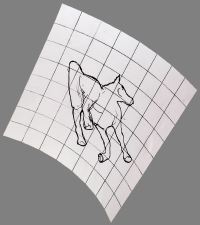
Tracing
of a shadow of the plastic horse on paper attached to
a model curved ceiling.
The curvature of the grid-lines shows the form of the model
ceiling. Rough interior
contours added free-hand after tracing shadow. Although the
"ceiling" is curved, the
figure appears in correct perspective when seen, as here, from the
intended viewing location.
|
|

A red
chalk drawing of the plastic horse.
The silhouette of the horse was traced from a shadow
(onto a flat
sheet for this drawing), while inner contours, details, and
shading were drawn free-hand while observing the plastic model.
This
red chalk drawing captures a particular lighting of the model.
Certain parts of the figure are drawn to different scale, for
the
purpose of studying finer details. The drawing was completed in
about an hour. The detail in this regular 2-dimensional
drawing could be used to
fill in the detail for the distorted shadow outline above (right column). |
|
|
|
|
|
Drawing, Sculpture, and the Sistine Chapel
Ceiling
The traditional interpretation of
Michelangelo's figure studies is really only a guess
Analysis based
on research
at the 2005/6 Teylers Museum hosting of the Michelangelo
Drawings exhibition, and at the Vatican
(short summary here)
By Karl Zipser
12
March 2006
Michelangelo's
Lost Three-Dimensional "Sketches"
The historical Michelangelo
Drawings
exhibition (British Museum through 25 June) gives a
sense of seeing the artist at work, of watching masterpieces take shape
from the most
humble beginnings. This feeling is perhaps justified, because
drawing
was an essential tool for Michelangelo's preparation of larger
works. And yet, before jumping to conclusions about
what his drawings
tell us, it is critical to realize that there was another type of
preparatory "sketch" that Michelangelo used: his small
three-dimensional figure models. These
models are almost
entirely lost 1,
and it is easy to overlook their importance. But they
probably played as critical a role in Michelangelo's creative process
as drawing on paper. By ignoring how this class of work
relates to the drawings,
which the Michelangelo
Drawings exhibition for the most part does, it becomes
impossible to reach a
full understanding of how Michelangelo worked; it is difficult to say
with confidence what were the purposes, or even the subjects, of some
of his best drawings.
Any doubts about the importance of the preparatory model are dispelled
by Michelangelo's own words in one of his sonnets:
When
divine Art conceives a form or face,
She bids the craftsman for his first
essay
To shape a simple model in mere clay:
This is the earliest birth of Art's
embrace.
In
these lines Michelangelo describes forming a clay model as preparation
for carving a marble sculpture. His celebration of the humble
medium
of clay should not to be dismissed as poetic license, because he wrote
from his own experience. Michelangelo's clay models must have
been
remarkable sculptures in their own right; most likely they
rivaled the beauty of his drawings on paper. A clay model attribute to
Michelangelo is show in the left column.
Despite the survival of a few models of questionable authenticity, for
the most part the lost
clay models cannot speak to us or inform our understanding, unless we
can find some further trace of them. The
colossal marble sculpture
does not
easily reveal to the imagination its humble origins of clay 2.
But
where to search for the lost models? As I said
above, the Michelangelo
Drawings exhibition gives a sense of seeing the
master at work. If there is any real basis to this
impression, if the
drawings really do
provide a picture of how Michelangelo worked, then
the place to search for the lost clay models is in the drawings
themselves. Of course, the impression of "seeing the master
at work"
from the drawings might be an illusion. But as we shall see,
Michelangelo's drawings will not leave us disappointed in the quest to
rediscover the lost models.
Michelangelo's
Drawings and the Three Elements:
Imagination,
Reality,
and Style
Although
Michelangelo's finished masterpieces are impressive for their awesome
dimensions, he confronted his core creative challenges at a smaller
scale; the lines from the sonnet quoted above make this
clear. But reducing the scale of an artwork does not in
itself simplify the
complexity of its content. Even working on a small scale, an
ambitious
artist like Michelangelo had to confront a daunting challenge of
combining
three distinct elements: the freedom of his imagination, the
constraints of realistic form, and the interpretation of style.
While
the still-life painter or the abstract painter can in part escape these
challenges by abandoning imagination, in the first case, or the
constraints of depicting reality, in the second, Michelangelo
confronted the full challenge of bringing together these three elements
of art. And yet there is every indication that he
did so
not in a wild, reckless, or heroic manner; but rather, that he used a
systematic approach, divided his problems into parts, and created a
successful fusion using his deliberate preparations.
To see the
evidence of this in the Michelangelo
Drawings exhibition, we can look at 1) drawings which
are clearly made from imagination, 2) drawings that are
non-idealized studies of the living or dead human bodies, and 3)
drawings connected to the stylistic content of ancient sculpture.
Drawing
from
Imagination
A
rudimentary compositional sketch for the Judith and Holofernes
scene in the Sistine Chapel (see left column) contains little
sense of realism or
style. It
is a pure work of imagination, an early statement of what the final
fresco scene should contain. Perhaps it is nothing more than
a sort of
visual shopping list, making a record of what will be needed, with an
approximate location for each figure. It is not an especially
good drawing, but
it was probably in some way useful to Michelangelo, and to us it
provides valuable
information. We see that Michelangelo's artworks could grow
from the
most humble imaginary beginnings.
Drawings
of
Realistic Human Form
Some
of Michelangelo's least artistic drawings are those in which he seems
to
make a faithful record of what he saw. For example, he made
brown pen and ink drawings
of the arm muscles of a flayed corpse, diagrams full
of information,
but of little immediate aesthetic value [Studies of flayed arms,
(left column)].
Here we see Michelangelo collecting data on human form,
but not
idealizing or interpreting it immediately. The data is left
in a raw
form. This does not make for the most interesting picture,
but as a
faithful record, this anatomical data could serve him in later
work.
Another
example of Michelangelo working, apparently with an effort to record
realistic form, is in a drawing of two male heads [Two
heads, right column)].
The faces depicted here have a sense of realism, a prosaic quality of
everyday life. The faces are not idealized or heroic, they
are quite
unlike what we think of as Michelangelo's artistic vision of
man. And
yet, as faithful records, like the anatomical data, they could serve as
a basis for later work.
The drawings of realistic form not only
show a dispassionate side of the fiery-tempered Michelangelo.
They
also show him dividing his problem into parts literally, by using
separate
studies for different parts of the body.
Drawings
from Ancient
Sculpture
Michelangelo
made extensive drawing studies of ancient Roman marble
sculptures. It
is clear that he was interested in the poses of the figures, but
perhaps even
more in their style. Unfortunately, the Michelangelo Drawings
exhibition does
not
contain drawings of ancient sculpture that are obviously made directly
from sculpture itself, although such drawings exist. But
his
experimentation with drawing variations on the pose of the ancient Apollo
Belvedere sculpture [e.g., left column, A
group of three
nude men;
right column, A
youth beckoning] show evidence, within the
exhibition itself, of his
fascination with ancient sculpture pose and style. Here is
evidence of
the proud Michelangelo borrowing the ideas of other artists.
In
the drawings described above we have seen Michelangelo at work with the
three elements: the imaginary, the realistic, and the
stylistic. Although these are
perhaps mediocre
from an artistic standpoint, this does not detract from their
importance. These drawings show how Michelangelo studied each
of the
three
elements of art, to some degree in isolation, in much the same
way that he sometimes
studied different parts of the body in separate drawing
studies.
Michelangelo's great masterpieces did not arise in a single step, like
God's
creation of Adam as described in Genesis.
Rather, as the drawings discussed above show, he built,
or at least had the
option to build, his complex artistic world from the simplest
elements.
Bringing
the
Elements Together:
Drawings for the Sistine Chapel Ceiling Frescoes
Michelangelo's
great challenge, of course, was to combine the three elements,
imagination, reality, and style. The fact that he studied
each in
isolation (too some degree) implies that when he wished to bring these
elements together,
he could do so using the results of his separate studies, using his own
drawings as data. When he brought
these
elements together in drawing, he produced rich artworks; but these
drawings are inherently more difficult to classify into the elementary
categories that have been discussed above.
Perhaps the most beautiful and
ambiguous of Michelangelo's surviving drawings are his magnificent red
chalk works for the Sistine Chapel ceiling, listed below:
Study for
a seated male nude (left column)
Study for
Adam (left column)
Studies
for Haman (right column)
Studies
for the Crucifixion of Haman (right column)
I will refer to these as "the red chalk drawings". These
drawings have the following in common:
1) each
contains a remarkable representation of male human form;
2) each is closely related to the appearance of the figures in the
ceiling frescoes;
3) each is a highly refined drawing with rich anatomical detail;
4) each shows an incomplete figure, with the representation of the body
divided into parts, not necessarily consistent in scale;
5)
the poses are heroic in character, poses which would be
uncomfortable, or impossible, for a live model to maintain for a
sustained length of time;
6) the figures do not look like ordinary
people, but like ideal human forms, with style clearly related to, but
still distinct from, ancient Greek and Roman sculpture.
Together
these common qualities point to the drawings not being merely pure
works of imagination, studies from reality, or quotations from ancient
sculpture. Rather, their common qualities show that the
drawings are a
synthesis combing all three elements. How then should we
answer the
simplest of questions: who, or what,
were the subjects for these
drawings?
The Michelangelo Drawings
exhibition provides a definitive answer -- these red chalk drawings are
studies of live human
models. This is stated as a "fact" by British Museum drawings
curator Hugo Chapman 3
in the volume that accompanies the exhibition. Although
the makers of the exhibition recognize that Michelangelo has
brought together the three distinct artistic elements in these
drawings, they fail to follow the line of reasoning to the logical
conclusion.
How can the exhibition be so certain that Michelangelo drew these
figures from life?
Is it not equally likely that these magnificent drawings are in fact
depictions of small clay models? 4
The
functional connection between 3-dimensional and 2-dimensional
artworks
Although
he does not mention it in the sonnet quoted above, we know that
Michelangelo used drawing as an aide in making sculpture.
That is to
say, Michelangelo used 2-dimensional drawings, such as the remarkable
studies for the figure of 'Day' to
guide in the creation of 3-dimensional
physical form. But conversely, sculpture has been equally
valuable
for making drawings; that is to say, using the 3-dimensional to create
the 2-dimensional. We have already seen one aspect of this in
Michelangelo's use of ancient sculpture. But drawing from
ancient
sculpture has the inherent limitation that one must accept the
3-dimensional sculpture as one finds it.
Another approach, which gives more
flexibility to the artist, is described by Cennino Cennini in his "Il
Libra dell'Arte", written perhaps in the 1390's. After
describing
drawing and painting techniques in great detail, Cennini in the final
section of his book writes "I will tell you about something else which
is
very useful and gets you great reputation in drawing, for copying and
imitating things from nature: and it is called casting." 5
Cennini
proceeds to explain how to make life-casts of human faces and complete
figures, using plaster of Paris.
Life-casting
is a simple way to
make realistic sculpture
(left column). Cennini makes it clear that an
artist,
without possessing the skills of a sculptor, can create life-like
three-dimensional forms; these forms he can draw or paint at his
leisure to create a result that seems to have been made from life,
without the disadvantages of working from a restless human
model. The
implications of Cennini's writing are profound. They suggest
that
whenever we see any portrait or figure in an old painting or drawing,
we must consider the possibility that we are in fact looking at an
image of a life-cast, not a living person. This was perhaps
standard practice.
Of course,
life-casting also has limitations. The artist can only make a
life-cast from a real person, and must accept the person as he finds
him. The life-cast will be life-sized, and thus unwieldy and
heavy.
But if the artist possesses the skills of the sculptor, he
can
make his
own life-like forms to draw. Michelangelo, one of the
greatest
sculptors and draftsmen of all time, had a unique opportunity to create
life-like models, and to draw them so that they looked alive.
This I
propose is precisely what he did with the Sistine Chapel red chalk
drawings listed above. These drawings thus could rescue from
oblivion
some of Michelangelo's lost 3-dimensional "sketches". If we take
another look at the clay torso model show earlier with more dramatic lighting (right
column)
we can see how inviting a subject for drawing these models could have
been. Whether this particular model is an authentic
Michelangelo
is to some degree irrelevant; we only need to look at it as an example
of what Michelangelo could have made, and could have drawn.
Although
there is not any question that Michelangelo could have done
this, it
would seem to represent extra work in the context of a project like
frescoing the Sistine Chapel. From Michelangelo's drawings it
is clear
that he was not prone to do extra or unnecessary labor. For
example,
in a refined drawing of a figure, he would typically leave a hand or
arm in rough schematic form, if he knew that these body parts
would be invisible in the finished artwork. Thus, to support
my
interpretation, it is necessary for me to describe some very solid
advantages that Michelangelo would receive from the labor of making
clay models for his figures.
Purposes
for making 3-dimensional models, when a 2-dimensional image is
the goal
There are three distinct reasons for creating clay models for the
Sistine chapel figures.
The
first reason relates to the three elements of art that we discussed
above. If Michelangelo made a design from his imagination, if
he had
realistic life-studies of human models to serve as data, and if
he had a deep understanding of ancient sculptural style, he nonetheless
still had a huge challenge to combine these three elements.
The Michelangelo
Drawings exhibition, by proposing that the red chalk
drawings are life studies,
puts the enormous burden on Michelangelo of combining the three
elements while looking at a live model, a figure most likely not of the
ideal form that he desired for his artwork. But if instead
Michelangelo integrated the three elements into a clay model, as I
propose, he could work at leisure to create precisely the ideal human
form
that he desired -- in much the same way we know he did when preparing
to carve a marble sculpture 6. If Michelangelo's live
model for
Adam were an old man with pot-belly, he could nonetheless transform
that
figure into an ideal form in clay 7.
He could copy a head
from an
ancient sculpture if the live model's head did not satisfy.
In
sum, the
clay model presents the ideal medium for Michelangelo to bring together
the three elements, imagination, reality, and style. To do so
while drawing a figure from life is
possible, but it would be far more difficult, unless the figure already
had something approaching the ideal form.
The second reason the clay models would be
useful is because of their rigid physical stability.
Michelangelo was
interested in
depicting the most heroic and difficult poses. By making
clay
models, he could turn life
into still-life,
and draw at leisure -- just
as Cennini describes with the life-casts. Drawing from the
clay is the optimal
condition for making drawings as refined as the red chalk
drawings.
Attempting to produce a refined result when drawing a live model, a
person perhaps trembling from the strain of the pose, would be far
more
difficult and frustrating.
As the first two reasons make
clear, creating clay models, which might at first seem like extra work,
would in fact ease Michelangelo's creative
burden. For
these
two reasons alone, my interpretation of the red chalk drawings, as
depictions of clay models rather than live models, is
justified. For these two reasons, we can be skeptical of the
exhibition's certain claim that these are life studies. As we
shall now see, the third reason for making the clay sculptures is that
they allow for a simple solution to one of the most difficult aspects
of the fresco project: getting the figures onto the Sistine Chapel
ceiling.
The
Most Important Advantage of Using 3-Dimensional Models in Creating
the Ceiling Frescoes
Candlelight
in the Chapel
Whether
Michelangelo's drawings are from life or from clay models, the artist
faced a number of problems in putting them on the Sistine Chapel
ceiling. For one thing, he would have to enlarge
them. Normally when
artists enlarged a drawing, they drew a system of square grids on their
drawing, then drew a larger system of grids on the surface to be
painted, such as a panel, a canvas, or a wall. They could
then enlarge
the drawing by comparing the grids. This type of
enlargement is
so simple that it could safely be left to assistants.
However, there
are no such grids on the surviving drawings for the
Sistine Chapel ceiling. At first this might seem
mysterious. However,
there is a good reason that there are no grids on the drawings: grid
enlargement would not have helped
Michelangelo to transfer his drawings to the ceiling 8.
The reason that grid enlargement would
have been of no help is that the Sistine chapel ceiling is not a flat
surface; rather, it consists of many curving
surfaces. The
grid
method would not give the correct perspective for enlarging the figures
from normal drawings
onto these curved surfaces. To transform a flat drawing onto
a curved
surface, but retain the correct perspective and foreshortening of the
figures, represents a major computational headache. The task
is
complex because it is necessary to take into consideration both the
curvature of the wall and
the physical structure of the figure in the
drawing. For example, there are places in the Chapel where
the wall
curves forward,
but the figure leans backward;
both factors need to be
taken into consideration to produce the correct perspective.
Today we could use a computer for the task. To do it without
a
computer would
require extensive computation by hand, no evidence of which
exists.
How did Michelangelo do it then? The solution may be
this: although
it is difficult to enlarge a drawing,
such as that of the foreshortened
figure Haman, onto a curving ceiling, if, on the other hand, one has a three-dimensional model
of the figure, the process becomes
trivial.
All that is necessary is to arrange the figure in the correct pose
(perhaps suspending it with string, or supporting it with rods), and
then
use a candle to cast a shadow of the clay model onto the curving
ceiling. The enlargement and the
correction for the curvature
happen
automatically (see examples in left
and right
columns). With a computer today we could
simulate this
process with a virtual model of the figure, the wall, and the candle,
if no real three-dimensional model were available.
We
see then that Michelangelo would have a major incentive to create clay
models of his figures, in
order to get them onto the ceiling in the correct perspective -- if he
discovered the shadow projection technique.
It
could be objected that the sheer scale of the Sistine chapel, combined
with the particular structure of the scaffold used by Michelangelo to
reach the ceiling, might make it impossible to project clay models onto
the ceiling as I describe. This technical objection might
very well be
valid.
It all depends on the size of the clay models, the nature and strength
of the light source, and the exact structure of the scaffold.
However,
this technical objection is in no way
fatal to my argument. If
Michelangelo were for technical
reasons unable
to implement this scheme in the chapel itself, he could have achieved
the same result by projecting the shadows of clay models onto a simple model of the
Sistine Chapel ceiling 9.
Enlarging these
projections to the
chapel
itself would be a trivial matter of increasing the scale; the simple
grid
method would work (see examples in left
and right columns).
I have given three reasons for making the clay
models. Michelangelo might have initially made them for only
the first
two reasons. Having the clay models on the scaffold, he might
have
observed the effects of shadow enlargement by accident. But
with the
clay models ready, he could easily take advantage of the discovery.
Of
course the candle projection would give a result that was perfect for
only one viewpoint (in this case at the position of the
candle). But this
is a general limitation of
all perspective projections, for paintings on flat as well as curved
surfaces. Whatever method Michelangelo
used,
it would always
have this
drawback. This is inherent limitation of representing
3-dimensional
form or a 2-dimensional surface, whether flat or curved.
From
Shadow to Fresco
The
method of casting a shadow on the chapel ceiling (or a model ceiling)
would give the outline, or
silhouette of the clay model, but not any of the other internal
features -- in the same way that our own shadows delineate our outer
contours, but not our eyes or mouths (except of course when the
shadows are perfect profiles). In order to paint the frescoes,
Michelangelo would, of course, need more than the simple outline of the
figures. The task of adding features to the projected
silhouettes is
relatively straight-forward, because the artist can use the outer
counters as guides for where the internal features should be.
Michelangelo could refer to the
clay
models directly, or drawings of them, when adding the features to the
projected drawing.
A red chalk study of the horse
(left column) would likewise enable us to fill in the details for a
fresco cartoon.
Earlier
it seemed necessary to justify why Michelangelo would have made clay
models of figures such as Haman. But at this point we could
ask a
different question. If he had the clay models, why should
Michelangelo
have made the refined red-chalk drawings of them? The fact
that these
drawings exist does not in itself explain their purpose. If
Michelangelo
made
clay models, as I described, and if he used them to project the outline
of the figures on the ceiling, he could have also referred to the
models themselves to add the other details to the projected
image. The
red-chalk drawings would thus seem to be unnecessary. Thus,
in a sense
we have come full circle in the argument.
We see now that the
refined nature of the red chalk drawings poses a difficulty for the
clay model shadow projection idea. If Michelangelo had the
clay models, it
seems that
the refined drawings would be unnecessary. But since the
refined red
chalk drawings exist, we must show how they would still be essential to
the project, along with the proposed clay models. If we
cannot do
this, then we
are forced to assume that Michelangelo made these refined red chalk
drawings for no particular reason. Since this would be
absurd, it
would cast doubt on the clay model idea.
The solution to this dilemma is simple, however. Although
Michelangelo could have used clay
models
to transfer line
drawings of his figures to the ceiling (by tracing the
shadow, and adding interior contours referring to the model), he still
needed to paint the frescoed figures with the appropriate light and shade.
Theoretically, he could have painted from the models
directly. However, there is a problem in doing
this. The lighting
in the Chapel by
which he worked in painting the frescoes would likely not be the same
as
the lighting he wanted for his clay figures. Moreover,
because the
frescoes are large, he would have to move the clay figures around as he
changed position, in order to always view them from the correct
angle.
An easier solution than painting the frescoes directly from clay models
would be to make refined
shading studies of the clay
figures, using the correct lighting, and then to refer to these as he
painted. This, I believe, is the purpose of the refined
red chalk drawings in the Michelangelo
Drawings exhibition, such as that of Adam, Haman, and the Ignudo.
Thus, the red chalk drawings still have a fundamental role to play in
the making the frescoes, even if Michelangelo made clay
figures. A
drawing has advantages
that a clay model lacks, as a reference for painting: portability,
invariance over different
lighting conditions, and constant viewing angle of the figure.
Previously it was assumed that
the
refined red chalk drawings in the Michelangelo
Drawings exhibition are an early stage of the project --
something from which full-scale, refined cartoons could be
made. With
my interpretation, the cartoons -- that is, full scale drawings to be
attached to the ceiling itself to allow the drawing to be transferred
to
the wet plaster -- would need be no more than minimalistic outlines and
interior contours. The refined red chalk drawings we see in
the exhibition could be a
primary source for the fresco painting detail. This is
an
attractive idea, because it explains why the drawing are executed with
such refinement. It is also an exciting idea because it puts
the drawings
we see much closer to the final result: Michelangelo might have even
held these drawings in his hand as he painted.
The fact that
the
drawings are incomplete -- missing heads or arms -- is of no
importance. Michelangelo would have had these pieces on
separate
sheets, or even on the same sheets, as was his habit. To
paint the
head from one page, the body from another, would present no
inconvenience, given that a complete outline and major interior
contours had been transferred from the cartoon to the wet
plaster.
In fact, dividing the figures into separate parts would make it be
easier to use them, because the heads could be made in larger sizes in
the drawing to show better detail.
No full-sized fresco
cartoons for the Sistine Chapel ceiling have survived. Vasari
suggests that Michelangelo burned the cartoons. Perhaps this
was
not as absurd as it sounds
-- if the fresco cartoons were indeed as minimalistic as I suggest, and
that the best
drawing work was confined to the small (red chalk) drawings, some of
which still exist and are on display in the exhibition.
Conclusion
We
began with a search for traces of Michelangelo's lost 3-dimensional
sketches. We found what could be careful depictions of some
of them in
the red chalk drawings for the Sistine Chapel ceiling.
During
the difficult years of creating the ceiling frescoes, the artist
signed his letters to his family with the title, "Michelangelo,
Sculptor in Rome." During this time he was not able
to
create the marble sculpture that was his passion, and it is easy
to regard this title "Sculptor" as more wishful thinking than as
directly connected to his activities from 1509 to
1513. And
yet, as we have seen
in this essay, the designation "Sculptor in Rome" could have been
literally true during the fresco project. Michelangelo may
have formed
clay models of his figures, and used them to transform his ideas onto
wet plaster. If we take Michelangelo at his word and consider
this
possibility, we are able to reinterpret the entire process of creation
of the ceiling frescoes of the Sistine Chapel.
|
Notes
1
A small collection of model figures was found in the Casa
Buonarroti
in Florence. There is some mystery surrounding their origin.
Other figure
models elsewhere have been attributed to Michelangelo as well, but
authenticity is generally a matter of controversy. The site Michelangelo's Models discusses these models in detail.
2
Michelangelo also modeled with wax, and perhaps other media.
Giorgio Vasari, Michelangelo's friend and biographer, records that the
sculptor carved the colossal marble 'David' from a small wax
model.
Clay is the more plastic and sensuous medium, whereas the wax model is
less fragile. Although I refer to clay models in this essay,
wax could
fulfill the same role.
3 "As
with the earlier Cascina figure studies, the fact that
Michelangelo was drawing from a model did not prevent him from
adjusting the forms for artistic effect." See Hugo Chapman's Michelangelo Drawings: Closer to
the Master, p. 129
4
The makers of the Michelangelo
Drawings exhibition are of course not
ignorant of the possibility that Michelangelo could draw from small
model figures. But they use this concept to reach an odd
conclusion. With reference to the fact that the drawing
technique for A
flying angel and other studies is crude and mechanical,
they
suggest that this may be a result of Michelangelo drawing from a small
model figure. Given Michelangelo's talents in sculpture and
drawing,
this argument is inexplicable; it is as if to
suggest
that Michelangelo would have found his own sculptural models
uninspiring subjects. In another essay I give a different
explanation for the quality of the
drawing in question, namely, that it may be a forgery.
5 Quoted
from Daniel Thompson's translation, The
Craftsman's Handbook. Cennini believed that
life-casting was
also the
basis of sculpture in ancient times, from which, he says "many good
figures and nudes are to be found." In light of the ancient
Roman
marbles that would be unearthed after Il Libro dell'Arte
was
written, Cennini's statement about "many good figures" is indeed
prescient.
6 The
only important difference is
that the
clay models for the Sistine Chapel would require less work, because
unlike the case of marble sculpture, the figures in the frescoes can
only be seen from a fixed viewpoint, not from any side.
Michelangelo
would not need to worry about the muscles of Adam's back, or the chest
of the Ignudo depicted from behind. In
other
words, making the clay models for the Sistine chapel would have been
familiar work to Michelangelo, but less demanding than what he was used
to in his usual work as a sculptor.
7 Michelangelo
was the master of
transformation from the real to the ideal. For example, in
what is
apparently a non-idealized life-study for a figure in the Sistine
Chapel ceiling frescoes [a drawing not in the Exhibition],
Michelangelo depicted "an elderly man with a slight paunch and sagging
buttocks. " Michelangelo somehow transformed this ordinary
man into
one of his heroic, gargantuan fresco figures; furthermore, in the
chapel, the figure is a woman. [See Michelangelo and the Pope's
Ceiling, by
Ross King].
8 Hugo
Chapman writes, "There are no known examples of Michelangelo squaring
his preparatory drawings so one can only assume that he copied them
freehand." p. 120. This freehand copying and enlarging of the
figures would be a huge amount of work, and very difficult because of
the curvature of the ceiling. As I explain, there is a much
simpler alternative.
9 A
model of
the Sistine chapel ceiling would have been of great help to
Michelangelo, whatever method he used to transfer his drawings to the
ceiling.
With the real
ceiling,
the artist standing on the scaffold sees a highly distorted view of his
work; the spectator standing far below on the chapel floor sees the work in
the correct perspective (if the scaffold does not block his view).
With a small
scale model of the ceiling, the artist can see his work in
correct perspective, and also
work at the same time.
To enlarge the design from the model ceiling to the full-scale ceiling
is trivial. Thus, working with a model ceiling offers an
advantage
in preparing designs for the ceiling frescoes, because the artist can
deal with the problem of the curved ceiling while working, and enlarge
the scale later.
Furthermore,
if Michelangelo had a small model of the ceiling with which to work, he
could position himself in the intended viewing position for the fresco
and draw at the same time. Working in the real chapel,
Michelangelo
could not stand in the intended view-point at the same time he
worked.
When seen from the intended viewpoint, the figures on the fresco would
not seem distorted by the curvature of the wall, by
definition. Thus,
drawing from this position is easy. However, from other
viewpoints,
particularly the extremely close viewpoint necessary to paint the
actual frescoes, the distortion of the figures would be extreme.
The
fact that the Sistine Chapel ceiling consists of a
small
number
of repeating elements means that a small set of simple models of the
ceiling would suffice. There would be no need to construct a
model of
the complete chapel ceiling. The model ceiling segments could
have
easily been constructed from wood.
Michelangelo was famous for working in secrecy. The technique
of
shadow projection I discuss is so simple and rapid that, if he used it,
he could easily have hidden the technique from his own assistants. |
|
References
Cennini, Cennino. Il
Libro dell'Arte. The Craftsman's Handbook.
Trans. Daniel V. Thompson. New Haven: Yale
University Press, 1933.
Chapman, Hugo.
Michelangelo Drawings: Closer to the Master.
London: The British Museum Press, 2005.
King, Ross. The Pope's Ceiling.
New York: Penguin Group, 2003.
Vasari, Giorgio. Lives
of the Painters, Sculptors, and Architects.
Trans. Gaston du C. de Vere. 2 vols. London:
Everyman's Library, 1996
|
|
| Text
and non-Michelangelo images © Copyright Karl Zipser 2006, all
rights reserved. |
Essay List
Karl Zipser's Homepage
|
|
|
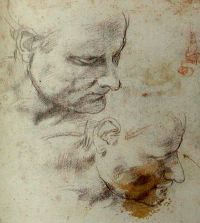
Two Heads
Black
chalk on paper
c. 1534-36
|
|
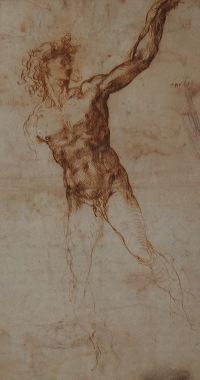
A youth beckoning
Pen
and brown ink on paper
c. 1504-5
|
|
|
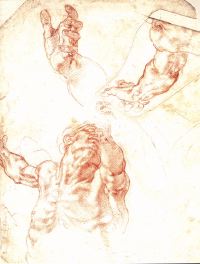
Studies for Haman
Red chalk on paper
c. 1511-1512
|
|

Studies for the Crucifixion of
Haman
(monochrome reproduction)
Red chalk on paper
c. 1511-1512
|
|
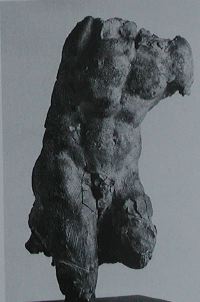
Model of a nude torso
clay
c. 1520
|
|
|
|
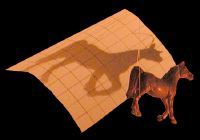
Closer
view of shadow projection. The shadow appears
distorted from this view, but from the position of the candle, the
shadow silhouette has the correct perspective.
|
|
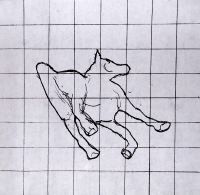
The
shadow projection drawing detached
from model "ceiling" and laid flat. In this geometry,
the
figure is distorted, the grid-lines straight. The grid makes
it
trivial to enlarge this (intentionally) distorted image to a
full-sized fresco cartoon to be attached to the real ceiling.
|
|
|
|
|
|
|
|